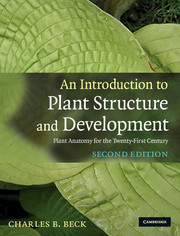Book contents
- Frontmatter
- Contents
- Preface to the second edition
- Preface
- Acknowledgements
- General references
- Chapter 1 Problems of adaptation to a terrestrial environment
- Chapter 2 An overview of plant structure and development
- Chapter 3 The protoplast of the eukaryotic cell
- Chapter 4 Structure and development of the cell wall
- Chapter 5 Meristems of the shoot and their role in plant growth and development
- Chapter 6 Morphology and development of the primary vascular system of the stem
- Chapter 7 Sympodial systems and patterns of nodal anatomy
- Chapter 8 The epidermis
- Chapter 9 The origin of secondary tissue systems and the effect of their formation on the primary body in seed plants
- Chapter 10 The vascular cambium: structure and function
- Chapter 11 Secondary xylem
- Chapter 12 The phloem
- Chapter 13 Periderm, rhytidome, and the nature of bark
- Chapter 14 Unusual features of structure and development in stems and roots
- Chapter 15 Secretion in plants
- Chapter 16 The root
- Chapter 17 The leaf
- Chapter 18 Reproduction and the origin of the sporophyte
- Glossary
- Index
- References
Chapter 9 - The origin of secondary tissue systems and the effect of their formation on the primary body in seed plants
Published online by Cambridge University Press: 05 June 2012
- Frontmatter
- Contents
- Preface to the second edition
- Preface
- Acknowledgements
- General references
- Chapter 1 Problems of adaptation to a terrestrial environment
- Chapter 2 An overview of plant structure and development
- Chapter 3 The protoplast of the eukaryotic cell
- Chapter 4 Structure and development of the cell wall
- Chapter 5 Meristems of the shoot and their role in plant growth and development
- Chapter 6 Morphology and development of the primary vascular system of the stem
- Chapter 7 Sympodial systems and patterns of nodal anatomy
- Chapter 8 The epidermis
- Chapter 9 The origin of secondary tissue systems and the effect of their formation on the primary body in seed plants
- Chapter 10 The vascular cambium: structure and function
- Chapter 11 Secondary xylem
- Chapter 12 The phloem
- Chapter 13 Periderm, rhytidome, and the nature of bark
- Chapter 14 Unusual features of structure and development in stems and roots
- Chapter 15 Secretion in plants
- Chapter 16 The root
- Chapter 17 The leaf
- Chapter 18 Reproduction and the origin of the sporophyte
- Glossary
- Index
- References
Summary
Perspective: role of the vascular cambium
As the vascular cambium becomes active and secondary tissues are formed, the consequent increase in diameter of the stem may have profound effects on the primary body. This is especially true in woody, arborescent taxa among conifers and dicotyledons. The vascular cambium is an extensive, permanent secondary meristem, one cell thick, conical in form, often described as cylindrical, that begins its development between primary xylem and primary phloem. In most gymnosperms and dicotyledons it is present in all main stems and roots and their branches, extending from near their tips to the bases of stems and roots. In some woody plants it even extends into leaf petioles. In most woody taxa it differentiates first in developing vascular bundles at about the same time as metaxylem begins its development (Figs 9.1a, b, 9.2), that is, after elongation in the provascular strands has ceased. This fascicular cambium may become active, producing some secondary xylem and phloem before cambial differentiation occurs between the bundles (Fig. 9.1b), that is, in the interfascicular regions. In many woody, arborescent taxa, additional provascular strands differentiate between the initial vascular bundles, often so close together that they may contact each other laterally (Fig. 9.1b, c). The vascular cambium then becomes continuous across the vascular bundles (Fig. 9.1c, d).
- Type
- Chapter
- Information
- An Introduction to Plant Structure and DevelopmentPlant Anatomy for the Twenty-First Century, pp. 157 - 165Publisher: Cambridge University PressPrint publication year: 2010

